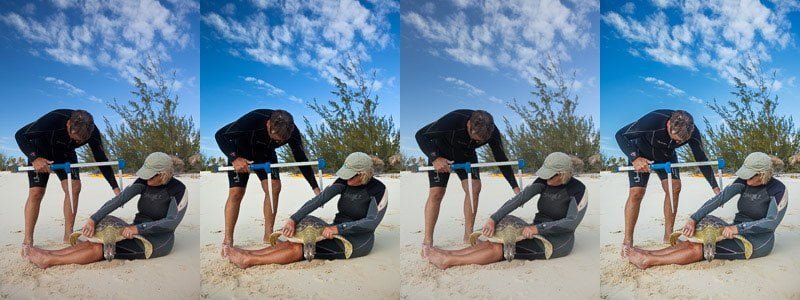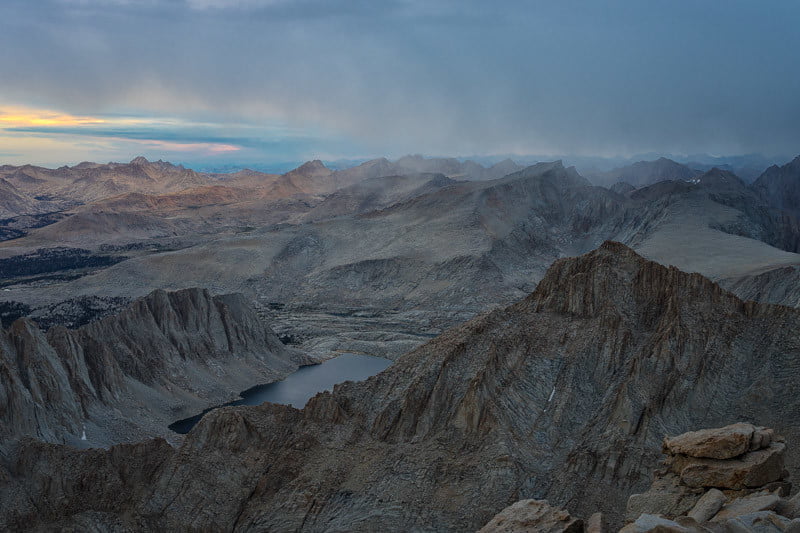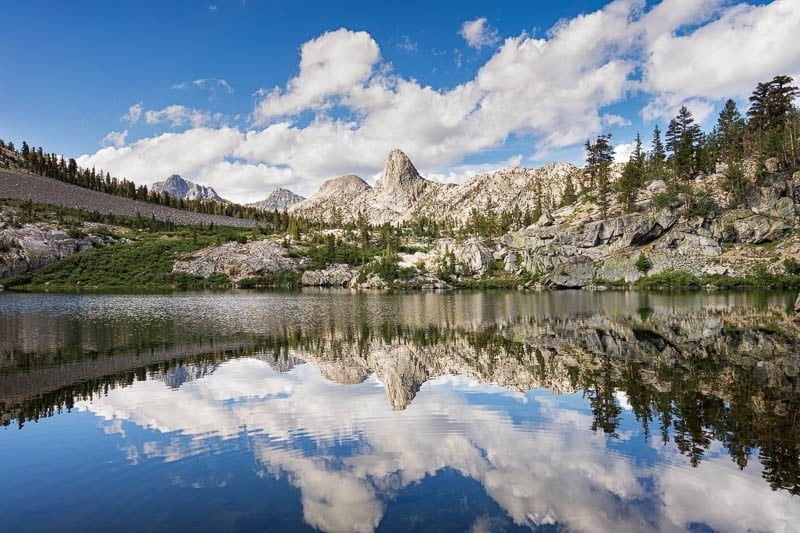Disclosure: This post may contain affiliate links. I earn a small commission of product sales to keep this website going.
Ansel Adams was known to say, “the negative is the score and the print is the performance.”
The guy would spend an entire day in the darkroom working on one photo, and forty years later he’d still be in the darkroom working on that same photo! He’d just be using different styles & techniques.
The digital world is no different. If you shoot in RAW (and you should be), that’s your negative. The good thing about RAW files, despite them being “flat and dull”, is that any changes you make in a RAW converter over time are not permanent to the file. The negative doesn’t change. Just the final product! And if you care about your photography, the final product should constantly be changing.
You can watch Ansel Adams discussing his Moon Over Hernandez photo in this interview, and see the differences between the original 1941 exposure and his adjustments from 1980. His 1980 version, made 40 years after the original exposure, is one of his most acclaimed photographs.
Why You Should Reprocess Your Photos
Styles & Tastes Change
My dad has been an oil painter for something like 50 years. Long time. He started doing realistic portraits and is now painting impressionistic landscapes. Quite the change, right?!
Well it’s okay to do the same as a photographer. Maybe you get into a “split toning” phase, or high-key black & whites, then you start to get into abstracts. You’re going to process all of these styles differently. And maybe you took a photo five years ago that was just, blah. Now you’re processing with a different style, and the picture rocks it!
The following photo from a market in Haiti presented a difficult color situation. Original colors just weren’t working. I originally processed it in black & white but recently started experimenting with split toning, this in yellows and blues to give it a bit of a vintage look. Which one do you prefer?

New Tools Become Available
Ten years ago I was mostly just using Adobe Lightroom for photo cataloguing. That was really all it was good for; I’d then open up each photo and process them as layered Photoshop files.
Then I discovered Nik software and processed most of my photos in their plugins.
But the latest improvements to Lightroom CC mean that I hardly ever open up Photoshop anymore, and I’ve ditched the Nik plugins. I can do just about everything in Lightroom now, so long as I’ve taken a technically & compositionally correct negative. This has drastically improved my workflow over the years.
Who knows, maybe I’ll find a new processing suite tomorrow that will again change my workflow.
The point being, why wouldn’t you revisit a recipe once you get better ingredients & cookware?
Go ahead and rework a photo in Lightroom that you previously worked in a third-party plugin years ago – you might be surprised by the results!

Very subtle changes over five years and four revisions – but the most recent looks significantly better than the first. All were processed in Lightroom, which also advanced significantly in that time.
You Should Always be Improving Yourself & Learning
Back to dad – even though he’s been painting for 50 years he’s reading a new painting book every time I see him. Always learning.
And again, the same goes with photo processing. I’ve been constantly reading new books & articles about Lightroom and learning processing techniques & new features of the program. Not just the “how to do it” but the nitty-gritty nuts & bolts of what is going on under the hood. This has enabled me to streamline my processing and create a final product much more appealing than what I was able to create ten years ago.
It’s also great practice – the more you revisit old photographs and reprocess them, the better you’ll be at processing new photos.
And Finally, It Will Bring You Success
I still by no means think I’m a great photographer. Or even a good one.
But I’ve managed to get the attention of editors and published in media with wide circulation. Photos that I took years ago, that I processed years ago, never would have had a chance of getting published.
With all of my own progression in processing those photos are now competitive. And believe me, the photography world is very competitive. So you’ll need all the advantage you can get! Your stock library should always have the most up-to-date, polished photos in it.
Have a goal: Choose a few photos each day and see if you can polish them some more.
Using Lightroom for Processing
Lightroom deserves its own separate blog, and there’s no shortage on the internet there. A short paragraph here isn’t enough, but I mentioned I use it almost exclusively now so here’s why. My understanding of its power has increased dramatically in the last year, and I’m sure I’m still not using it to its full potential.
My recent increase in knowledge of Lightroom has spurred me to reprocess many of my photos and I’ve loved the results.
One-Stop Shop
All of the things that I used to go to Photoshop for, now I just do in Lightroom.
- Merging panoramas while preserving the RAW format
- Masking graduated filters with auto-masking
- Dust spot detection
- Improved noise reduction & sharpen masking
- Total opacity control when dodging & burning
- Perspective transformation
- I’ve never been a huge HDR fan but there are times it’s necessary – Lightroom’s HDR conversion preserves the RAW format
Lightroom’s image catalogue system is amazing. Collections, ratings, color labels, keywording, and GPS location cataloguing make it an invaluable tool for photographers with large catalogs. And the cool thing about these catalogs is that it preserves your edit history – you can see how your photos looked ten years ago and compare to today. That’s kinda fun!
Lightroom Mobile was recently introduced and is gaining some amazing potential. It’ll sync your RAW files to your mobile device (small preview files), allowing you to make Lightroom adjustments on your phone while waiting for the bus. These adjustments are synced with your master Lightroom catalog on your computer.
Integration with Smugmug and my Blog
I’m a former Photoshelter user now hosting all of my photos on Smugmug. All (er, 95%) of the images on my blog are embedded from my Smugmug portfolios. They’re not hosted on WordPress.
Smugmug has a plugin for Lightroom and it syncs your Smugmug galleries & collections.
So whenever I make a change to a photo in Lightroom (adjust the toning or whatnot), that change is published to Smugmug and thus also on my blog. I don’t have to go through each post affected and re-upload the photo!
If you’re not familiar with Smugmug, they’re offering a 14-day trial and a 15% discount for new subscribers.
The bottom photo will automatically be updated whenever I rework it without me ever needing to go back into this blog post.





Dave Marr
Monday 20th of November 2017
John - thanks so much - really interesting and thought provoking article - I had never thought of revisiting the RAW files through time as tools and learning develops - but makes total sense - there are negatives you will cherish. Sadly I only discovered RAW mode and Lightroom very recently and so a lot of my key pics from years past are JPEG but even those are coming to life in Lightroom. I guess my next question to research is whether to save the Canon RAW files somewhere or whether the DNG conversions for LR processing are OK long term. Maybe in 30 years I'll pass my digital collection to my daughter for re-processing in Lightroom Classic 2035! Also enjoyed the Ansel Adams link. All the Best - Dave
John Peltier
Monday 20th of November 2017
Thanks for the feedback Dave! All is not lost with JPGs - there's still a little hope! The RAW/DNG conversion discussion is a tough one. DNG was supposed to address some apocalypse where there was going to be a need for a standard archival file format. I don't think that'll ever happen. You'll always be able to convert files to DNG if you need to. I did convert for a short while - like a couple days. But I just didn't like the idea of losing the file as it came out of the camera forever. You could keep backups of RAW files as you convert to DNGs, but that defeats one of the big reasons to convert (storage savings of about 10-15%). The conversion process strips some of the super-geeky camera-specific metadata, and that information is lost forever. Also, when you make basic changes to the image in Lightroom, the file itself is altered every time. I rather like the idea of having a sidecar file with the image corrections, and never actually touch the RAW file itself. I'm sure someone else could make an equally compelling argument for DNG, but that's mine. Keep the files as they came out of the camera, a true digital negative.